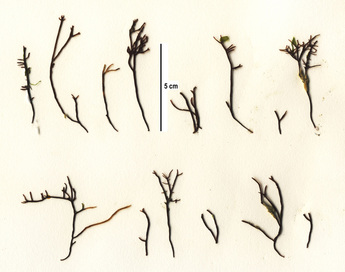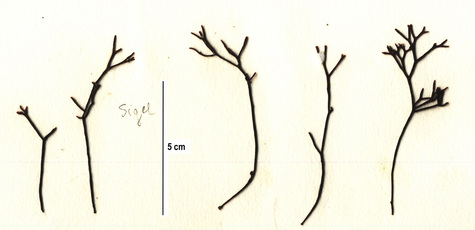Loose Ahnfelt's Seaweed • Ahnfeltiopsis gigartinoides
{Ahnfeltiopsis = for Swedish botanist Nils Otto Ahnfelt}
|
Loose Ahnfelt's seaweed from Calvert Island beaches; specimen collection numbers SCL 15363 (left) and SCL 14997 (right) in the UBC Herbarium Algae Database. Images courtesy of Sandra Lindstrom. Search the collection numbers in the database for further details on these specimens, or search this species for additional occurrences.
|
Identification
This red alga is composed of open dichotomous branching and grows to 25 cm tall from a horizontal creeping branch (basal rhizome). The branches are stiff and cylindrical in cross-section, with a diameter of about 1 mm. It is dark brownish-red or purplish-red to black; younger section of individuals may be lighter in colour. This species has a crustose tetrasporophyte stage.
Habitat & Range
Loose Ahnfelt's seaweed grows on rock in the mid-to low intertidal and upper subtidal, and is often surrounded by or partly immersed in sand. Its extends from the western Gulf of Alaska and the Bering Sea to Mexico.
Similar Species
Loose Ahnfelt's seaweed is often associated with the smaller bushy Ahnfelt's seaweed (Ahnfeltia fastigiata) and, from southern BC south, the larger flat-tipped forked seaweed (Ahnfeltiopsis linearis). Bushy Ahnfelt's seaweed reaches 15 cm tall, is tightly branched and wiry, and is smaller, with branches 0.25 to 0.5 mm in diameter.
This red alga is composed of open dichotomous branching and grows to 25 cm tall from a horizontal creeping branch (basal rhizome). The branches are stiff and cylindrical in cross-section, with a diameter of about 1 mm. It is dark brownish-red or purplish-red to black; younger section of individuals may be lighter in colour. This species has a crustose tetrasporophyte stage.
Habitat & Range
Loose Ahnfelt's seaweed grows on rock in the mid-to low intertidal and upper subtidal, and is often surrounded by or partly immersed in sand. Its extends from the western Gulf of Alaska and the Bering Sea to Mexico.
Similar Species
Loose Ahnfelt's seaweed is often associated with the smaller bushy Ahnfelt's seaweed (Ahnfeltia fastigiata) and, from southern BC south, the larger flat-tipped forked seaweed (Ahnfeltiopsis linearis). Bushy Ahnfelt's seaweed reaches 15 cm tall, is tightly branched and wiry, and is smaller, with branches 0.25 to 0.5 mm in diameter.
References
Druehl, L. 2000. Pacific Seaweeds: A guide to common seaweeds of the west coast. Harbour Publishing: Madeira Park, BC, Canada. P. 122.
Lamb, A., and Hanby, B. (2005). Marine Life of the Pacific Northwest [electronic version]. Madeira Park, BC: Harbour Publishing.
O'Clair, R. and Lindstrom, S. Ahnfeltiopsis gigartinoides (J. Agardh) P.C. Silva et DeCew. In Klinkenberg, Brian. (Ed.). E-Flora BC: Electronic Atlas of the Plants of British Columbia. Lab for Advanced Spatial Analysis, Department of Geography, University of British Columbia, Vancouver. Accessed 30/03/2015.
Authors and editors of page
Kelly Fretwell and Brian Starzomski (2015).
Druehl, L. 2000. Pacific Seaweeds: A guide to common seaweeds of the west coast. Harbour Publishing: Madeira Park, BC, Canada. P. 122.
Lamb, A., and Hanby, B. (2005). Marine Life of the Pacific Northwest [electronic version]. Madeira Park, BC: Harbour Publishing.
O'Clair, R. and Lindstrom, S. Ahnfeltiopsis gigartinoides (J. Agardh) P.C. Silva et DeCew. In Klinkenberg, Brian. (Ed.). E-Flora BC: Electronic Atlas of the Plants of British Columbia. Lab for Advanced Spatial Analysis, Department of Geography, University of British Columbia, Vancouver. Accessed 30/03/2015.
Authors and editors of page
Kelly Fretwell and Brian Starzomski (2015).





